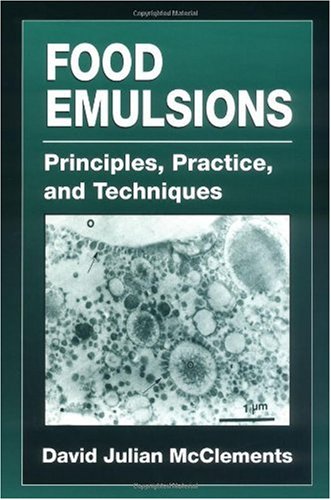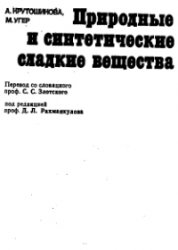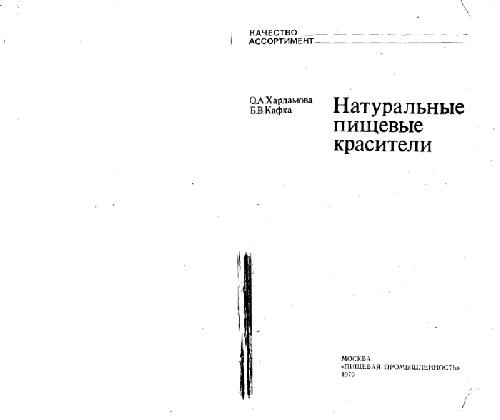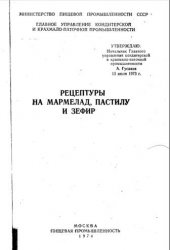David Julian McClements0849380081, 9780849380082
Table of contents :
FOOD EMULSIONS Principles,Practice,and Techniques……Page 1
Table of Contents……Page 3
Preface……Page 9
The Author……Page 10
1.1. EMULSION SCIENCE IN THE FOOD INDUSTRY……Page 11
Table of Contents……Page 0
1.2.1. Definitions……Page 12
1.2.2. Mechanisms of Emulsion Instability……Page 14
1.2.3. Ingredient Partitioning in Emulsions……Page 15
1.3.1. Dispersed-Phase Volume Fraction……Page 16
1.3.2.1. Presenting Particle Size Data……Page 17
1.3.2.2. Mean and Standard Deviation……Page 18
1.3.2.3. Mathematical Models……Page 20
1.3.3. Interfacial Properties……Page 21
1.3.4. Droplet Charge……Page 23
1.4. HIERARCHY OF EMULSION PROPERTIES……Page 24
1.5. INVESTIGATION OF EMULSION PROPERTIES……Page 25
1.6. OVERVIEW AND PHILOSOPHY……Page 26
2.2. FORCES OF NATURE……Page 27
2.3.1. Covalent Interactions……Page 28
2.3.2. Electrostatic Interactions……Page 29
2.3.3. van der Waals Interactions……Page 33
2.4. OVERALL INTERMOLECULAR PAIR POTENTIAL……Page 36
2.5. BOND STRENGTHS AND THE ROLE OF THERMAL ENERGY……Page 38
2.6.1. Thermodynamics of Mixing……Page 39
2.6.2. Potential Energy Change on Mixing……Page 40
2.6.4. Free Energy Change on Mixing……Page 41
2.6.5. The Properties of More Complex Systems……Page 42
2.7. MOLECULAR INTERACTIONS AND CONFORMATION……Page 43
2.8.2. Hydrophobic Interactions……Page 45
2.9.1. Monte Carlo Techniques……Page 46
2.9.2. Molecular Dynamics Techniques……Page 47
3.2. COLLOIDAL INTERACTIONS AND DROPLET AGGREGATION……Page 48
3.3.1. Origin of van der Waals Interactions……Page 51
3.3.3. Hamaker Function……Page 52
3.3.4. Electrostatic Screening……Page 53
3.3.6. Influence of an Interfacial Layer……Page 55
3.4.1. Origins of Surface Charge……Page 57
3.4.2. Ion Distribution Near a Charged Surface……Page 58
3.4.2.1. Inner Region……Page 61
3.4.3. Electrostatic Interactions Between Charged Droplets……Page 63
3.4.3.1. Charge Regulation……Page 65
3.4.3.2. Effect of Electrolyte on Surface Potential……Page 66
3.4.5. General Features of Electrostatic Interactions……Page 67
3.5.1. Polymeric Emulsifiers……Page 68
3.5.2.1. Mixing Contribution……Page 69
3.5.3. Distance Dependence of Polymeric Steric Interactions……Page 71
3.5.4. Optimum Characteristics of Polymeric Emulsifier……Page 72
3.5.5. General Features of Polymeric Steric Stabilization……Page 73
3.6.1. Origin of Depletion Interactions……Page 74
3.6.2. Interdroplet Pair Potential……Page 75
3.6.3. General Features of Depletion Interactions……Page 76
3.7. HYDROPHOBIC INTERACTIONS……Page 77
3.8. HYDRATION INTERACTIONS……Page 79
3.9. THERMAL FLUCTUATION INTERACTIONS……Page 80
3.9.2. Undulation Interactions……Page 81
3.10. HYDRODYNAMIC INTERACTIONS AND NONEQUILIBRIUM EFFECTS……Page 82
3.11.1. van der Waals and Electrostatic……Page 83
3.11.2. van der Waals, Electrostatic, and Steric……Page 85
3.11.3. van der Waals and Steric……Page 86
3.11.4. van der Waals, Electrostatic, and Hydrophobic……Page 87
3.11.5. van der Waals, Electrostatic, and Depletion……Page 88
3.12. PREDICTING COLLOIDAL INTERACTIONS IN FOOD EMULSIONS……Page 89
4.1. INTRODUCTION……Page 91
4.2. FATS AND OILS……Page 92
4.2.1. Molecular Structure and Organization……Page 93
4.2.3. Fat Crystallization……Page 94
4.2.3.1. Supercooling……Page 96
4.2.3.2. Nucleation……Page 97
4.2.3.3. Crystal Growth……Page 99
4.2.3.5. Polymorphism……Page 100
4.2.3.6. Crystallization of Edible Fats and Oils……Page 101
4.2.4. Chemical Changes……Page 102
4.3.1. Molecular Structure and Organization……Page 103
4.4. AQUEOUS SOLUTIONS……Page 105
4.4.1. Interaction of Water with Ionic Solutes……Page 106
4.4.2. Interaction of Water with Dipolar Solutes……Page 108
4.4.3. Interaction of Water with Nonpolar Solutes: The Hydrophobic Effect……Page 109
4.5.1. Molecular Characteristics……Page 112
4.5.2.1. Critical Micelle Concentration……Page 113
4.5.2.4. Surface Activity and Droplet Stabilization……Page 114
4.5.3.1. Bancroft’s Rule……Page 115
4.5.3.2. Hydrophile–Lipophile Balance……Page 116
4.5.3.3. Molecular Geometry and the Phase Inversion Temperature……Page 117
4.5.3.4. Other Factors……Page 118
4.6.1. Molecular Characteristics……Page 119
4.6.2.1. Hydrophobic Interactions……Page 120
4.6.2.3. Hydrogen Bonding……Page 121
4.6.2.5. Disulfide Bonds……Page 122
4.6.2.7. Molecular Conformation and Aggregation……Page 123
4.6.3.1. Protein Hydration and Water Solubility……Page 124
4.6.3.2. Emulsification……Page 127
4.6.3.3. Thickening and Stabilization……Page 128
4.6.3.4. Gelation……Page 130
4.6.5. Ingredient Selection……Page 132
5.2.1. Interfaces Between Two Pure Liquids……Page 134
5.2.2. Interfaces with Adsorbed Emulsifiers……Page 135
5.2.2.1. Surface Activity and the Reduction of Interfacial Tension……Page 136
5.2.2.2. Adsorption Kinetics of Emulsifiers to Interfaces……Page 137
5.2.2.3. Conformation of Emulsifiers at Interfaces……Page 138
5.3.2. Gas–Liquid Interface in the Presence of an Emulsifier……Page 139
5.3.4. Measurement of the Surface Excess Concentration……Page 141
5.4. PROPERTIES OF CURVED INTERFACES……Page 142
5.5. CONTACT ANGLES AND WETTING……Page 143
5.6. CAPILLARY RISE AND MENISCUS FORMATION……Page 146
5.7.1. Movement of Molecules to an Interface……Page 147
5.7.2. Incorporation of Emulsifier Molecules at an Interface……Page 148
5.8. COMMON TYPES OF INTERFACIAL MEMBRANES……Page 149
5.9. INTERFACIAL COMPOSITION AND COMPETITIVE ADSORPTION……Page 150
5.10.1. Du Nouy Ring Method……Page 153
5.10.2. Wilhelmy Plate Method……Page 155
5.10.3. Sessile- and Pendant-Drop Methods……Page 156
5.10.4. Drop-Volume Method……Page 157
5.10.6. Maximum Bubble Pressure Method……Page 158
5.10.7. Oscillating Jet Method……Page 159
5.10.8. Capillary Wave Method……Page 160
5.11.1. Measurement of Interfacial Shear Rheology……Page 161
5.11.2. Measurement of Interfacial Dilatational Rheology……Page 162
5.12. CHARACTERIZATION OF INTERFACIAL STRUCTURE……Page 163
5.13. PRACTICAL IMPLICATIONS OF INTERFACIAL PHENOMENA……Page 166
6.2. OVERVIEW OF HOMOGENIZATION……Page 167
6.3.1. Droplet Disruption……Page 169
6.3.1.2. Disruptive Forces……Page 170
6.3.2. Droplet Coalescence……Page 175
6.3.3. The Role of the Emulsifier……Page 176
6.4.1. High-Speed Blenders……Page 177
6.4.2. Colloid Mills……Page 178
6.4.3. High-Pressure Valve Homogenizers……Page 179
6.4.4. Ultrasonic Homogenizers……Page 180
6.4.5. Microfluidization……Page 181
6.4.6. Membrane Homogenizers……Page 182
6.4.7. Homogenization Efficiency……Page 183
6.5.1. Emulsifier Type and Concentration……Page 184
6.5.2. Energy Input……Page 185
6.5.3. Properties of Component Phases……Page 186
6.6. DEMULSIFICATION……Page 187
6.6.2. Ionic Surfactants……Page 188
6.7. FUTURE DEVELOPMENTS……Page 189
7.1. INTRODUCTION……Page 191
7.2.1. Thermodynamics……Page 192
7.2.2. Kinetics……Page 194
7.3. GRAVITATIONAL SEPARATION……Page 195
7.3.1.1. Stokes’ Law……Page 196
7.3.1.2. Modifications of Stokes’ Law……Page 197
7.3.2.1. Minimize Density Difference……Page 201
7.3.2.3. Modify Rheology of Continuous Phase……Page 202
7.3.3. Experimental Measurement of Gravitational Separation……Page 203
7.4.1. Physical Basis of Flocculation……Page 205
7.4.1.1. Collision Frequency……Page 206
7.4.1.2. Collision Efficiency……Page 208
7.4.2. Methods of Controlling Flocculation……Page 209
7.4.2.2. Collision Efficiency……Page 210
7.4.3.1. Influence of Colloidal Interactions on Floc Structure……Page 215
7.4.3.2. Use of Fractal Geometry to Describe Floc Structure……Page 216
7.4.3.3. Influence of Floc Structure on Emulsion Properties……Page 217
7.4.4. Experimental Measurement of Flocculation……Page 218
7.5. COALESCENCE……Page 219
7.5.1.2. Coalescence Induced by Prolonged Contact……Page 220
7.5.1.3. Coalescence as the Result of “Hole” Formation……Page 221
7.5.1.4. Coalescence in Surfactant-Stabilized Systems……Page 222
7.5.2.2. Prevention of Membrane Disruption……Page 224
7.5.3. Influence of Emulsifier Type and Environmental Conditions……Page 225
7.5.4. Experimental Measurement of Droplet Coalescence……Page 226
7.6. PARTIAL COALESCENCE……Page 227
7.6.1. Physical Basis of Partial Coalescence……Page 228
7.6.2.1. Prevention of Extended Close Contact……Page 230
7.6.3. Experimental Measurement of Partial Coalescence……Page 231
7.7. OSTWALD RIPENING……Page 232
7.7.1. Physical Basis of Ostwald Ripening……Page 233
7.7.2.4. Droplet Composition……Page 234
7.8.1. Physical Basis of Phase Inversion……Page 235
7.8.1.2. Fat Crystallization–Induced Phase Inversion……Page 236
7.8.2.4. Temperature……Page 237
7.9. CHEMICAL AND BIOCHEMICAL STABILITY……Page 238
8.1. INTRODUCTION……Page 240
8.2.1.1. Ideal Elastic Solids……Page 241
8.2.1.2. Nonideal Elastic Solids……Page 242
8.2.2.1. Ideal Liquids……Page 243
8.2.2.2. Nonideal Liquids……Page 244
8.2.3. Plastics……Page 248
8.2.4. Viscoelastic Materials……Page 249
8.2.4.1. Transient Tests……Page 250
8.2.4.2. Dynamic Tests……Page 251
8.3. MEASUREMENT OF RHEOLOGICAL PROPERTIES……Page 253
8.3.1. Simple Compression and Elongation……Page 254
8.3.2. Shear Measurements……Page 255
8.3.2.1. Capillary Viscometers……Page 256
8.3.2.2. Mechanical Viscometers and Dynamic Rheometers……Page 257
8.4.1. Dilute Suspensions of Rigid Spherical Particles……Page 259
8.4.2. Dilute Suspensions of Fluid Spherical Particles……Page 260
8.4.3. Dilute Suspensions of Rigid Nonspherical Particles……Page 261
8.4.4. Dilute Suspensions of Flocculated Particles……Page 262
8.4.5. Concentrated Suspensions of Nonflocculated Particles in the Absence of Colloidal Interactions……Page 264
8.4.6. Suspensions of Nonflocculated Particles with Repulsive Interactions……Page 266
8.4.7. Concentrated Suspensions of Flocculated Particles……Page 267
8.4.8. Emulsions with Semisolid Continuous Phases……Page 268
8.5.2. Rheology of Component Phases……Page 269
8.5.5. Particle Charge……Page 270
9.2. EMULSION FLAVOR……Page 272
9.2.1.1. Partitioning in Homogenous Liquids……Page 273
9.2.1.3. Influence of Flavor Binding……Page 276
9.2.1.4. Influence of Surfactant Micelles……Page 278
9.2.1.5. Partitioning in Emulsions in the Absence of an Interfacial Membrane……Page 279
9.2.1.6. Partitioning in Emulsions in the Presence of an Interfacial Membrane……Page 280
9.2.2. Flavor Release……Page 282
9.2.2.1. Release of Nonvolatile Compounds (Taste)……Page 283
9.2.2.2. Release of Volatile Compounds (Aroma)……Page 285
9.2.3.2. Concentration Analysis in Static Binary Liquids……Page 288
9.2.3.3. Concentration Analysis in Stirred Diffusion Cells……Page 289
9.3.1.1. Transmission, Reflection, and Refraction……Page 290
9.3.1.2. Absorption……Page 291
9.3.1.3. Scattering……Page 292
9.3.1.4. Absorption and Scattering in Concentrated Emulsions……Page 295
9.3.2.2. Color……Page 296
9.3.3.1. Spectrophotometry……Page 297
9.3.3.3. Colorimetry……Page 298
9.3.3.4. Sensory Analysis……Page 299
10.1.2. Quality Control……Page 300
10.2.1. Emulsifying Capacity……Page 301
10.2.2. Emulsion Stability Index……Page 302
10.2.4. Interfacial Rheology……Page 303
10.3.1.1. Conventional Optical Microscopy……Page 304
10.3.1.2. Laser Scanning Confocal Microscopy……Page 306
10.3.1.3. Electron Microscopy……Page 307
10.3.1.4. Atomic Force Microscopy……Page 311
10.3.2.1. Principles……Page 312
10.3.2.2. Measurement Techniques……Page 314
10.3.2.3. Applications……Page 315
10.3.3.2. Measurement Techniques……Page 316
10.3.4. Electrical Pulse Counting……Page 319
10.3.5. Sedimentation Techniques……Page 320
10.3.5.2. Centrifugation……Page 321
10.3.6.1. Principles……Page 322
10.3.6.2. Measurement Techniques……Page 323
10.3.7. Nuclear Magnetic Resonance……Page 325
10.3.8. Neutron Scattering……Page 326
10.3.10. Electroacoustics……Page 327
10.4.2.1. Principles……Page 328
10.4.2.2. Measurement Techniques……Page 329
10.4.3.1. Principles……Page 330
10.5.1.1. Principles……Page 331
10.5.1.3. Applications……Page 332
10.5.2.2. Measurement Techniques……Page 333
10.5.3.2. Measurement Techniques……Page 335
10.5.3.3. Applications……Page 336
10.5.4.1. Principles……Page 337
10.5.4.3. Applications……Page 338
10.6.1. Electrophoresis……Page 339
10.6.3. Electroacoustics……Page 340
References……Page 343







Reviews
There are no reviews yet.